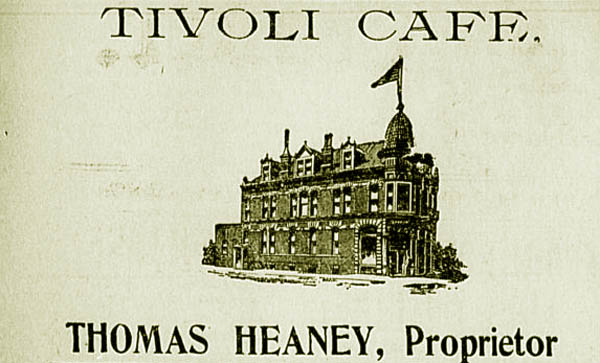
The Tivoli, 1904.
Not withstanding such structures as the Commercial Block, the Wrangler Building, the Atlas Theatre, probably the most distinctive structure on
West 16th Street is the circa 1892 Tivoli Building. constructed by Warren Richardson (1864-1960).
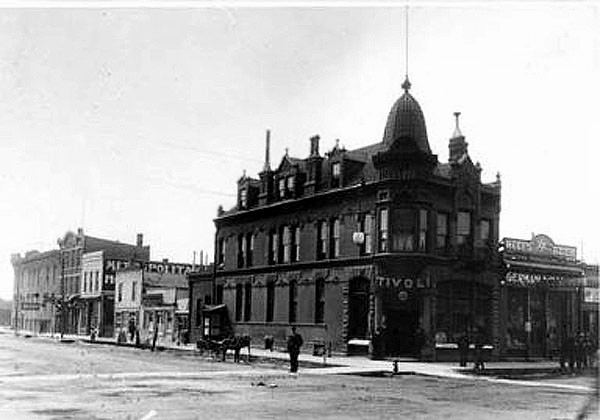
The Tivoli, 1892.
The structures to the south of the Tivoli on Ferguson (now Carey) is the Metropolitan Hotel which was owned byJohn W. Griffin (1848-1918). Following Griffin's death, the property
was acquired by the Colorado and Southeren Railroad, a part ofthe Burlington System, and was leased out to
Daisy Robinson and Sam Polulos.
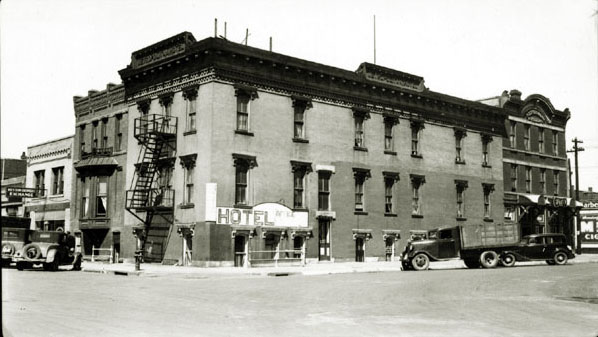
The Metropolitan Hotel Building, 1934.
The bulding immediately past the convertible coupe is the Western Growers Exchange. The "Hotel" sign marks the
steps leading down to the hotel office.
By 1920, the Metropolitan Hotel was no longer being shown as a "first class" facility in the "Official Hotel Red Book and Directory."
It was listed, but not as a first
class hotel. The area was one in which women would not venture. "Ladies" would venture, but not
women. Across from the Metropolitan were the "Dixie Rooms" popular with railroad workers. The ladies who lived in the Dixie Rooms would make house calls
across the street at the Metropolitan. In December 1921, the City apparently had enough. On December 25, the State Tribune rported that Sam and Daisy had been arrested and the hotel
was regarded as a "public nuisance." On January 6, 1922, the paper reported that the two were convicted and sentenced to three months in jail as a result of "obscene happenings" in the hotel.
As of 2011 the site of the hotel is a parking lot.
By 1904, the Tivoli was being operated by
Thomas Heaney (1854-1916) who previously operated a saloon at 315 W. 17th Street. By 1904, the saloon on 17th Street was operated by Williams & Myers who advertised it as
Hearney's "Old Stand."
The architecture of the Tivoli is a wonderous eclectic mixture of Queen Anne and Moorish
Revival. Over the years, it has housed restuarants, saloons, a small department store (Sam Marchick & Sons), offices, and
on the upper floors there were small cubicles utilized by lusty customers allegedly for "conversations" with ladies. It has been speculated that the
Tivoli received its name from the Tivoli Brewery in Denver which in turn had taken its name from the
amusement park in Copenhagen.
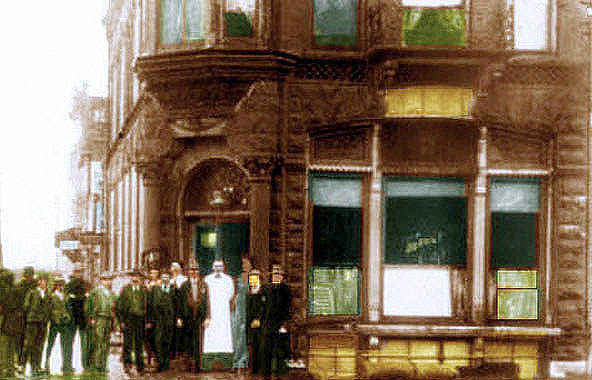
Patrons and habitues posing in front of
Tivoli Building, southwest corner of 16th and Carey Ave., undated.
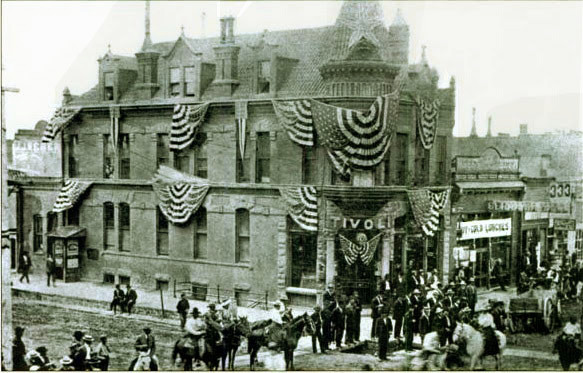
Tivoli Building, undated.
The one-story building to the right advertises hot and cold lunches.
The Tivoli Building has now been restored by
Governor Matt Mead. It now houses an upscale tap room.
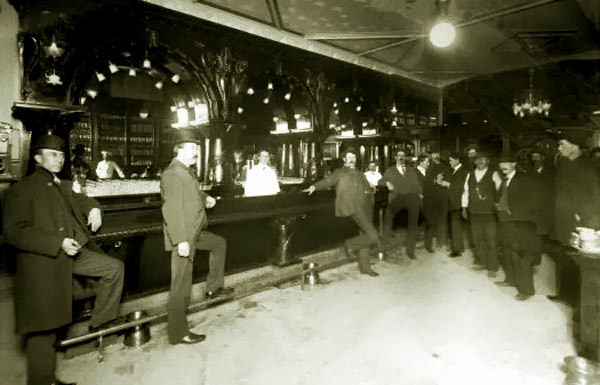
Interior, Tivoli Saloon, undated.
With the advent of prohibition, the building was sold in 1919 to Sam Marchik who used it for a clothing and samll department
store.
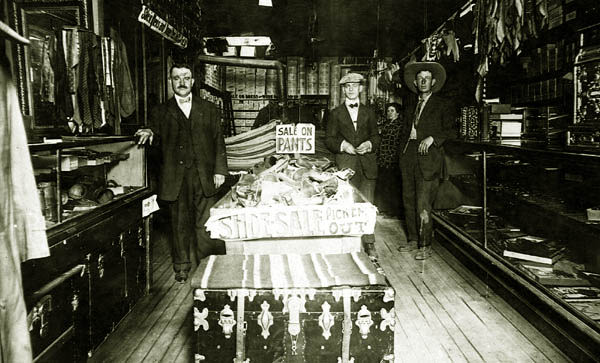
Interior Marchick & Sons.
The Marchvick family continued to own the building until 1976.
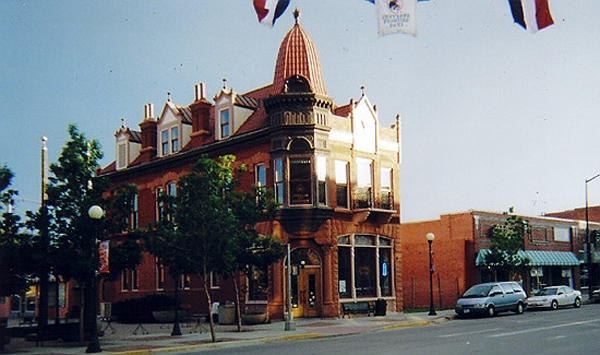
Tivoli Building, southwest corner of 16th and Carey Ave., 2005. Photo
by Geoff Dobson.
In 1907, Thomas Heaney acquired the Atlas Building at 213 W. West 16th Street. The building was
constructed in the 1887 and housed commercial establishments on the first floor and offices on the
second and third floors. He expanded the building by constructing an auditorium to the rear and converted the building into
a motion picture theatre. Heaney at the time also had an interest in the Capitol Theatre on Capitol Avenue. He served as president of the Industrial
Club (1908-1910 and 1913-1914), a predecessor of today's Chamber of Commerce.
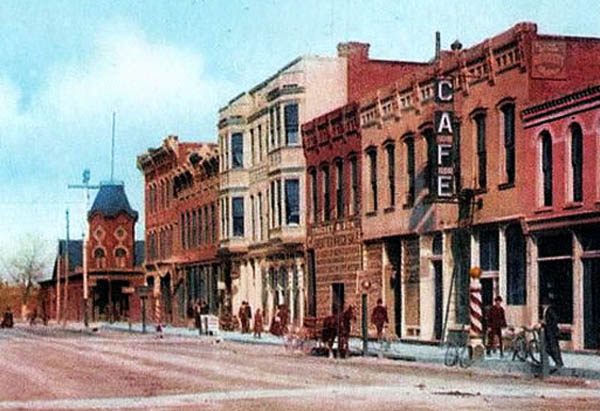
Southside of 200 Block of West 16th Street, Approx.
1890.
In the distance is the Burlington Station. To its right is the Phoenix Block. The pink building is the
Atlas Building.
In the theatre, Heaney opened a penny arcade, a confectionary and a soda fountain. The Daily Leader extolled the
concession stand:
Here is the largest and most costly soda fountain in the entire west.
The fountain is massively, yet gracefully, beautiŽful, with its marble
counter, nickled fixtures, great French plate mirror, weathered oak
woodwork and softly shaded electric lights. A score of patrons may be served simultaneously at the fountain counter and many more will find accommodation at nearby tables.
Back of the soda fountain is the confectionery salesroom, the walls of
which are panelled with French plate mirrors set in weathered oak.
The confectionery display cases are of solid plate glass and of rarely
graceful design. Throughout the room will be illuminated by electric lights under antique shades.
The fittings of the confectionery room are in keeping with the theater,
the significance of which assertation you will underŽstand when you have
seen them both.
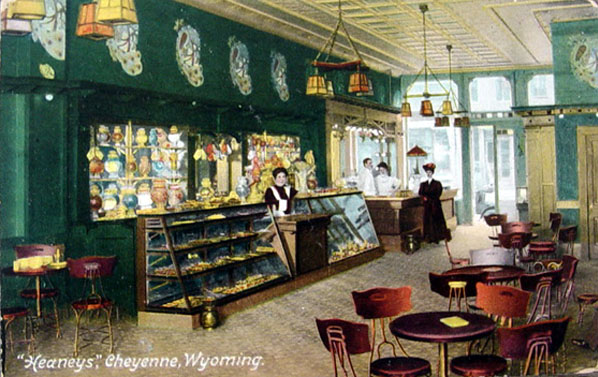
Thomas Heaney's Confectionary Shop and Soda Fountain,
Atlas Theatre, approx. 1908.
Music to accompany the action on the screen was provided by the Atlas Orchestra.
In 1930, the theatre after extensive remodling and installation of the latest in sound equipment reopened as the
"Strand." The upper floors housed the Strand Hotel. Use of the building as a theatre was discontinued between 1955 until 1961. From 1961 until 1963, when it became the
"Pink Pony" .
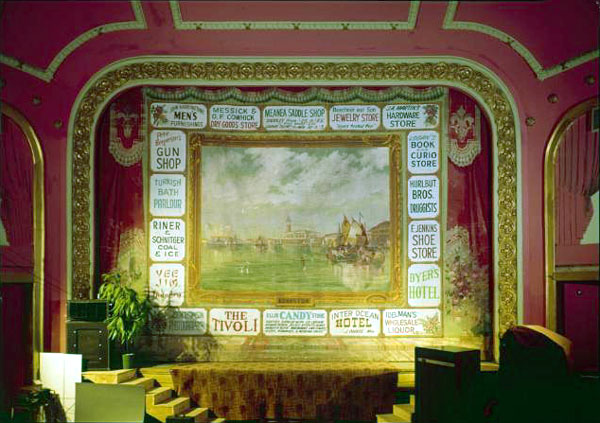
Curtain and proscenium Atlas Theatre, Courtesy Library of Congress.
In 1971 the theatre was acquired by the Cheyenne Litte Theatre and the structure became the
Atlas once again.
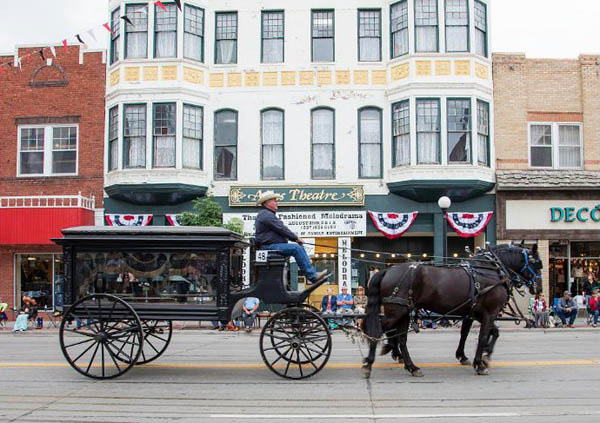
Atlas Theatre, 2015. Photo by Carol Highsmith courtesy of Library of Congress.
Cheyenne Photos continued on next page, the Wrangler Building, Becker Hotel.
|